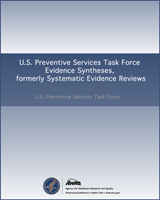NCBI Bookshelf. A service of the National Library of Medicine, National Institutes of Health.
Guirguis-Blake JM, Senger CA, Webber EM, et al. Screening for Chronic Obstructive Pulmonary Disease: A Systematic Evidence Review for the U.S. Preventive Services Task Force [Internet]. Rockville (MD): Agency for Healthcare Research and Quality (US); 2016 Apr. (Evidence Syntheses, No. 130.)
This publication is provided for historical reference only and the information may be out of date.

Screening for Chronic Obstructive Pulmonary Disease: A Systematic Evidence Review for the U.S. Preventive Services Task Force [Internet].
Show detailsTable 15Study Characteristics of Smoking Cessation Trials
| Study, Year Quality | Country Recruitment | N Randomized | Followup | Inclusion | Exclusion | Treatment Comparison | Primary Outcome(s) | Secondary Outcome(s) |
|---|---|---|---|---|---|---|---|---|
| Kotz, 2009121 Kotz, 2007166 Kotz, 2009124 Kotz, 2009167 Fair | Netherlands General population (ads, flyers, posters, and mailings) and primary care practices | 296 | 12 months | Ages 35–70; ≥10 pack-year history; read/speak Dutch; ≥1 respiratory symptom (cough, sputum, shortness of breath); mild or moderate COPD*; interested in quitting smoking | Prior respiratory diagnosis; spirometry in past 12 months; contraindication to nortriptyline; FEV1 <50% predicted; FEV1/FVC >70% | IG1: CG1 intervention plus discussion of results from spirometry, prognosis of COPD, and challenging irrational beliefs about smoking CG1: 4 40-minute medium-intensity counseling plus nortriptyline CG2: Referral to GP for smoking cessation treatment without information about spirometry results or airflow limitation | Prolonged abstinence from smoking (biochemically validated) | Nicotine dependence (FTND), respiratory health (CCQ), HRQoL (CRQ) |
| Sippel, 1999122 Fair | US Primary care clinics, invitation of all smokers among routinely scheduled outpatients | 205 | 9 months | Smokers age 18+ | Non-English speaking patients, walk-in cases considered emergent | IG: CG intervention plus educational interpretation of spirometry and CO measurement results CG: Individual cessation plan; cessation counseling; solicitation of quit date and clinic or telephone followup at 1 and 4 weeks after quit date (for patients in preparation stage) | Smoking cessation rate (self-reported) | Quit attempts, change in motivational stage |
| Risser, 1990120 Fair | US Randomly selected VA outpatients | 90 | 12 months | Smokers participating in a general preventive intervention VA Demonstration Project | NR | CG: 50-minute educational intervention with self-help program, invitation to a 4-month (9 sessions) one-on-one skills training and counseling program IG: CG intervention plus 10-minute motivational intervention based on spirometry, CO level, and discussion of pulmonary symptoms | Smoking status (self-reported and biochemically validated) | Quit attempts |
| Parkes 2008119 Fair | UK Five general practices | 561 | 12 months | Age ≥35; patient record indicates was a smoker within the last 12 months | Patients receiving oxygen; those with a history of lung cancer, TB, asbestosis, silicosis, bronchiectasis, or pneumonectomy | IG: Assessment interview including spirometry. Strongly encouraged to give up smoking and access local smoking cessation clinics. Patients received their “lung age”† verbally using a graphic display and were counseled that smoking cessation would help to slow down the rate of deterioration of lung function. CG: Assessment interview including spirometry. Strongly encouraged to give up smoking and access local smoking cessation clinics. Patients received their lung function scores (FEV1) in the mail with no further explanation. In both groups, if testing indicated asthma, participants were advised to attend GP for management and GP was informed separately. When spirometry suggested restrictive lung disease, participant and GP were sent letter to advise them on further investigation and guidelines on referral to secondary care. | Smoking cessation (biochemically validated) | Change in daily consumption of cigarettes; identification of new diagnoses |
| McClure, 2009123 McClure, 2009168 McClure, 2010169 Fair | US Community (health plan records, Quitline data, mailing list of smokers, ads) | 542 | 12 months | Smokers; age 18+; read and write English; CO level consistent with current smoking (≥10 ppm) and an average of 15 cigarettes per day for the past year or 10 cigarettes per day for ≥10 years | Currently receiving cessation treatment; significant physical or mental impairment that prevents the use of a computer or phone or impaired comprehension ability; medical contraindication for spirometry | IG: CG intervention plus personally-tailored report with self-reported smoking-related symptoms, smoking-related medical conditions, CO level and values of normal CO of nonsmokers, spirometry test and results (FEV1, FVC, FEF25–75), lung age‡ for individuals with FEV1 <80% predicted, graph demonstrating the effect of smoking cessation on lung function, information on the association between smoking and various health conditions. CG: Personalized health risk report and brief (~20 minute) counseling; advice to quit smoking, smoking cessation materials, access to free phone counseling program | Use of counseling program, 7-day point prevalent abstinence (self-reported) | Motivation to quit, quit attempts, use of other smoking cessation treatments, 30-day point prevalent abstinence (self-reported) |
- *
Postbronchodilator FEV1/FVC <70% and FEV1 ≥50% predicted.
- †
Men: Lung age=2.87 × height (in inches) − (31.25 × observed FEV1 (in liters) − 39.375; Women: Lung age=3.56 × height (in inches) − (40 × observed FEV1 (in liters) − 77.28
- ‡
Calculated using Morris and Temple method.155
Abbreviations: CCQ = Clinical COPD Questionnaire; CG = control group; CO = carbon monoxide; COPD = chronic obstructive pulmonary disease; CRQ = Chronic Respiratory Questionnaire; FEF25–75 = average forced expiratory flow during the mid (25%–75%) portion of the FVC; FEV1= forced expiratory volume in 1 second; FTND = Fagerstrom Test for Nicotine Dependency; FVC = forced vital capacity; GP = general practitioner; HRQoL = healh-related quality of life; IG = intervention group; N = number; NR = not reported; ppm= parts per million; TB = tuberculosis; UK = United Kingdom; US = United States.
- Table 15, Study Characteristics of Smoking Cessation Trials - Screening for Chro...Table 15, Study Characteristics of Smoking Cessation Trials - Screening for Chronic Obstructive Pulmonary Disease
Your browsing activity is empty.
Activity recording is turned off.
See more...
